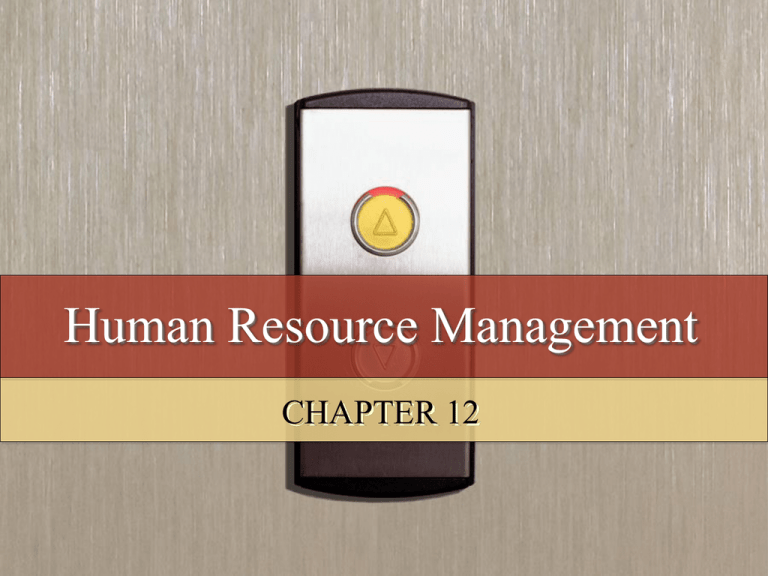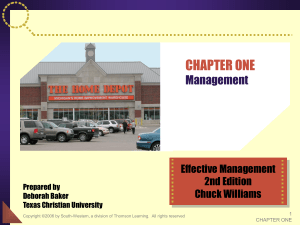
Human Resource Management
CHAPTER 12
Learning Objectives
2
Explain the role of human resource
management in organizational strategic
planning.
Describe federal legislation and societal trends
that influence human resource management.
Explain what the changing social contract
between organizations and employees means
for workers and human resource managers.
Show how organizations determine their future
staffing needs through human resource
planning.
Copyright © 2008 by South-Western, a division of Thomson Learning. All rights reserved.
Learning Objectives (contd.)
3
Describe the tools managers use to recruit and
select employees.
Describe how organizations develop an
effective workforce through training and
performance appraisal.
Explain how organizations maintain a workforce
through the administration of wages and
salaries, benefits, and terminations.
Copyright © 2008 by South-Western, a division of Thomson Learning. All rights reserved.
The Strategic Role of Human Resource
Management
All managers
are resource
managers
Employees are
viewed as
assets
Matching process,
integrating the
organization’s
goals with
employees’ needs
How a company manages its workforce may be single
more important factor in sustained competitive success
4
Copyright © 2008 by South-Western, a division of Thomson Learning. All rights reserved.
Current Strategic Issues
Determine a company’s need for skills and employees
5
Becoming more competitive globally
Improving quality, productivity, &
customer service
Managing mergers & acquisitions
Applying new information technology for
e-business
Copyright © 2008 by South-Western, a division of Thomson Learning. All rights reserved.
Exhibit 12.1
Strategic Human Resource Management Goals
Company Strategy
Attract an Effective Workforce
HRM Environment
Legislation
Trends in society
International events
Changing
technology
HRM planning
Job analysis
Forecasting
Recruiting
Selecting
Maintain an Effective Workforce
Wage and salary
Benefits
Labor relations
Terminations
6
Develop an Effective Workforce
Training
Development
Appraisal
Copyright © 2008 by South-Western, a division of Thomson Learning. All rights reserved.
Environmental Influences on HRM
7
Competitive Strategy
–
Building Human Capital
–
Globalization
–
Information Technology
Federal Legislation
Copyright © 2008 by South-Western, a division of Thomson Learning. All rights reserved.
Globalization
8
IHRM = addresses the complexity that
results from recruiting, selecting,
developing, and maintaining a diverse
workforce on a global scale
Copyright © 2008 by South-Western, a division of Thomson Learning. All rights reserved.
Information Technology
9
Human resource information technology = an
integrated computer system designed to
provide data and information used in HR
planning and decision making
Traditional HR to e-HR significantly affected
every area of human resource management
Some organizations are close to a paperless
HRM system – saves time, money, frees staff
Copyright © 2008 by South-Western, a division of Thomson Learning. All rights reserved.
Federal Legislation
10
Discrimination = hiring or promoting of
applicants based on criteria that are not
job relevant
Affirmative action = policy requiring
employers to take positive steps to
guarantee equal employment
opportunities for people within protected
groups
Copyright © 2008 by South-Western, a division of Thomson Learning. All rights reserved.
Major Federal Laws - HRM
Exhibit 12.3
11
Equal Opportunity/Discrimination Laws
Compensation/Benefits Laws
Health/Safety Laws
Copyright © 2008 by South-Western, a division of Thomson Learning. All rights reserved.
The Changing Social Contract
Exhibit 12.4
New Contract
Old Contract
Employee
Employability, personal responsibility
Partner in business improvement
Learning
Job security
A cog in the machine
Knowing
Employer
Continuous learning, lateral career
movement, incentive compensation
Creative development opportunities
Challenging assignments
Information and resources
Traditional compensation package
Standard training program
Routine jobs
Limited information
SOURCE: Based on Louisa Wah, “The New Workplace Paradox “ Management Review, January 1998,7; and Douglas T. Hall and
Jonathan B. Moss, “The New Protean Career Contract: Helping Organizations and Employees Adapt,” Organizational Dynamics,
winter 1998, 22-37.
12
Copyright © 2008 by South-Western, a division of Thomson Learning. All rights reserved.
HR Issues in the New Workplace
13
Employer of choice
Teams and Projects
Temporary Employees
Technology
Work-Life Balance
Downsizing
Copyright © 2008 by South-Western, a division of Thomson Learning. All rights reserved.
HR Issues in the New
Workplace
14
Employer of
Choice
An employer of choice is a company that is
highly attractive to potential employees
because its human resource practices focus on
both
–
Tangible benefits and
–
Intangible benefits
Copyright © 2008 by South-Western, a division of Thomson Learning. All rights reserved.
HR Issues in the New
Workplace
15
Teams and
Projects
Teams and Projects – major trend in today’s workplace
With emphasis on projects, distinctions between job
categories and descriptions are collapsing
Many of today’s workers straddle functional &
departmental boundaries; handle multiple
tasks/responsibilities
Virtual team = made up of members who
–
are geographically or organizationally dispersed,
–
rarely meet face to face, and
–
do their work using advance information
technologies.
Copyright © 2008 by South-Western, a division of Thomson Learning. All rights reserved.
HR Issues in the New
Workplace
16
Temporary
Employees
In opening years of the 21st century,
largest employer in U.S. was a
temporary employment agency,
Manpower, Inc.
Temporary Employees do everything
from data entry to interim CEO
Contingent workers = people who work
for an organization, but not on a
permanent or full-time basis, including
temporary placements, contracted
professionals, or leased employees
Copyright © 2008 by South-Western, a division of Thomson Learning. All rights reserved.
HR Issues in the New
Workplace
17
Technology
Telecommuting and virtual teams are related
trends
Telecommuting = using computers and
telecommunications equipment to perform work
from home or another remote location
Work anywhere - wireless Internet devices,
laptops, cell phones, fax machines
Extreme telecommuting = people live nd work
in countries far away from the organization’s
physical location
Copyright © 2008 by South-Western, a division of Thomson Learning. All rights reserved.
HR Issues in the New
Workplace
Work-Life
Balance
Many European companies ahead of U.S. companies
18
Telecommuting is one way organizations
help employees lead more balanced lives
Flexible scheduling important in today’s
workplace – 27% of workforce/flexible hours
Broad Work-Life Balance initiatives – critical
retention strategy – on-site gym & childcare,
paid leaves & sabbaticals
Copyright © 2008 by South-Western, a division of Thomson Learning. All rights reserved.
HR Issues in the New
Workplace
19
Downsizing
Downsizing = intentional, planned reduction in
the size of a company’s workforce
Managers can smooth the downsizing process
–
Regularly communicating with employees
–
Providing them with as much information as possible
–
Providing assistance to workers who will lose their
jobs
–
Using training and development for remaining
employees
Copyright © 2008 by South-Western, a division of Thomson Learning. All rights reserved.
HR Issues in Attracting an Effective
Workforce
20
HR issues present many challenges for
organizations and HR managers as they
work toward the three primary HR goals
● Attracting
● Developing
● Maintaining an effective workforce
Copyright © 2008 by South-Western, a division of Thomson Learning. All rights reserved.
Matching Model
Attracting an Effective Workforce
An employee selection approach
in which the organization and the
applicant attempt to match each
other’s needs, interests, and
values
21
Copyright © 2008 by South-Western, a division of Thomson Learning. All rights reserved.
Attracting an Effective Workforce
Exhibit 12.5
HR Planning
Retirements
Growth
Resignations
Choose Recruiting
Sources
Select the
Candidate
Want ads
Headhunters
Internet
Application
Interview
Tests
Company Needs
Strategic goals
Current & future competencies
Market changes
Employee turnover
Corporate culture
Matching Model
Match with
Welcome New
Employee
Employee Contributions
Ability
Education
Creativity
Commitment
Expertise
Company Inducements
Employee Needs
Pay and benefits
Meaningful work
Advancement
Training
Challenge
Stage of career
Personal values
Promotion aspirations
Outside interests
Family concerns
22
Match with
Copyright © 2008 by South-Western, a division of Thomson Learning. All rights reserved.
Human Resource Planning
23
Forecasting of human resource needs
and the projected matching of individuals
with expected vacancies
●
? = New technologies emerging
●
? = Volume of business likely next 5-10
years
●
? = Turnover rate, how much is avoidable, if
any
Copyright © 2008 by South-Western, a division of Thomson Learning. All rights reserved.
Recruiting
●
24
Recruiting = activities or practices that
define the desired characteristics of
applicants for specific jobs
●
Internal – promote-from-within policies used
by many to fill high-level positions
●
External = recruiting newcomers from
outside has advantage of multiple sources
E-cruiting = use of Internet - fastestgrowing approach to recruiting
Copyright © 2008 by South-Western, a division of Thomson Learning. All rights reserved.
Basic Building Blocks
of HR Management
Job Analysis
Job Description
Job Specification
25
Copyright © 2008 by South-Western, a division of Thomson Learning. All rights reserved.
Selecting
26
Selection = process of determining the
skills, abilities, and other attributes a
person needs to perform a particular job
Validity = relationship between an
applicant’s score on a selection device
and his or her future job performance
Copyright © 2008 by South-Western, a division of Thomson Learning. All rights reserved.
Selecting (contd.)
27
Application form - device used for
collecting information about an
applicant’s education, previous job
experience, and other background
characteristics
Research = biographical information
inventories can validly predict future job
success
Copyright © 2008 by South-Western, a division of Thomson Learning. All rights reserved.
Interviewing An Applicant
Know what you want
Prepare a road map
Use open-ended questions
Do not ask irrelevant questions
Do not rush interview
Do not rely on your memory
28
Copyright © 2008 by South-Western, a division of Thomson Learning. All rights reserved.
Reasons For Not Asking
About Home Ownership
29
●
Might adversely affect applicants
chances at the job
●
Minorities and women may be less likely
to own a home
●
Home ownership is probably unrelated
to job performance
Copyright © 2008 by South-Western, a division of Thomson Learning. All rights reserved.
Interview as Predictor of Success
30
Interview is not generally a valid predictor of
job performance – has high face validity as a
selection tool
Panel interviews – candidate meets with
several interviewers who take turns asking
questions – increases interview validity
Computer-based interviews - complement
traditional interviewing information
Copyright © 2008 by South-Western, a division of Thomson Learning. All rights reserved.
Inappropriate or Illegal Questions
Employment Applications and Interviews
31
Race-related questions
Age
Religion
Gender
National origin
Marital/family status
Copyright © 2008 by South-Western, a division of Thomson Learning. All rights reserved.
Testing and Assessment
32
Employment Test = written or computerbased test designed to measure a
particular attribute such as intelligence or
aptitude
Assessment Center = technique for
selecting individuals with high
managerial potential based on their
performances on a series of simulated
managerial tasks
Copyright © 2008 by South-Western, a division of Thomson Learning. All rights reserved.
Developing an Effective Workforce
Following selection, next goal of HRM is to develop employees
Training and development = planned
effort to facilitate employees’ learning of
job-related skills and behaviors $ 51.1
billion spent in 2005
On-the-job training = an experienced
employee “adopts” a new employee to teach
him or her how to perform job duties
Cross
training
Mentoring
33
Copyright © 2008 by South-Western, a division of Thomson Learning. All rights reserved.
Performance Appraisal
Process of observing and evaluating an
employee’s performance, recording the
assessment, and providing feedback to the
employee
Steps
●
●
●
34
Observing and assessing performance
Recording the assessment
Providing feedback to employee
Copyright © 2008 by South-Western, a division of Thomson Learning. All rights reserved.
Making Performance Appraisals A Positive Force
1.
2.
35
The accurate assessment of
performance through the development
and application of assessment systems
such as a rating scale
Training managers to effectively use
the performance appraisal interview to
provide feedback that reinforces good
performance and motivate employee
development
Copyright © 2008 by South-Western, a division of Thomson Learning. All rights reserved.
Assessing Performance Accurately
36
360° Feedback Process
Performance Evaluation Errors
– Stereotyping
– Halo effect
– BARS – Behaviorally-anchored rating scale
Copyright © 2008 by South-Western, a division of Thomson Learning. All rights reserved.
Maintaining an Effective Workforce
37
Compensation
–
Wage and Salary Systems
–
Compensation Equity
–
Pay for Performance
Benefits
Termination
Copyright © 2008 by South-Western, a division of Thomson Learning. All rights reserved.
Termination
Value of termination for maintaining an effective
workforce is two fold
Employees who are poor
performers can be dismissed
Employers can use exit interviews
in a positive manner
38
Copyright © 2008 by South-Western, a division of Thomson Learning. All rights reserved.







